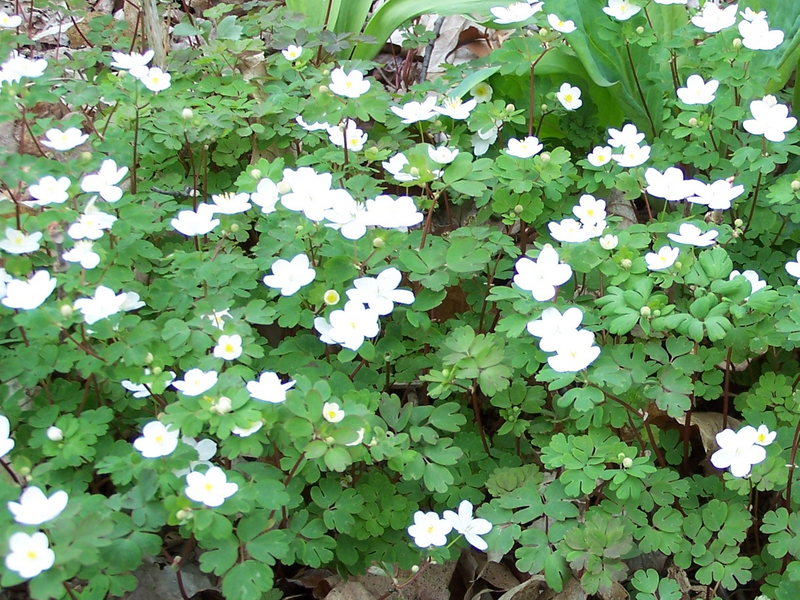Rue Anemone
Anemonella thalictroides
Click here to download a PDF of this plant information page (for printing).

Sun Exposure: Shade
Season of Interest: Spring, Summer, Fall
Bloom Time: March - May
Bloom Color: White/Pink/Lavender
Height: 4 to 8 in.
Spread: 6 to 10 in.
Spacing: 8 in.
Water Needs: Above average
Maintenance: Very little
Soil Type: High in organic matter
Soil pH: Acidic, Neutral
Soil Drainage: Well drained
Pests: Slugs
Diseases: None
Wildlife: Bees, Butterflies

Description:
A delicate spring-blooming perennial native to eastern North America, rue anemone is well-suited to wildflower or woodland gardens. Part of the buttercup family (Ranunculaceae), it grows in clusters and is spread via its thin tuberous root system. From a low clump of small basal leaves, one to six flower stalks extends up in spring, each with a single small white flower that is sometimes tinged with pink or lavender. After flowering, this ephemeral plant goes dormant and dies back as the heat of the summer arrives. It is a slow-growing plant but will gradually spread to fill available space, creating a long-lived colony. The Rue Anemone thrives in full shade making it perfect for those hard-to-fill spots in your garden where other plants may struggle. Its adaptability extends to various soil conditions as well, from moist to well-drained, making it a versatile choice for different garden settings. For more information see:
plants.ces.ncsu.edu/plants/anemonella-thalictroides
Care and Growing Tips:
Rue anemone is native to woodland areas so it shouldn't be a surprise that it prefers a shady spot. This makes the species a great choice for planting under deciduous tree canopies. In the spring, they'll receive the dappled light they prefer to grow in. When they go dormant during the summer, they'll still survive when the tree canopy is at its thickest and doesn't offer much light to the ground below. Rue anemone prefers loose, humus-rich loamy, or sandy soils, but it can cope with a variety of soil types. It does need to be well-drained. Because rue anemones can cope without too much moisture, this species won't need a lot of additional watering, especially if the area has a covering of mulch. Rue anemone is fairly drought tolerant, but keeping them moderately moist will ensure the longest bloom period in spring. Its drought tolerance is a benefit if the rue anemone is planted under large, well-established trees, which absorb a lot of the available moisture into their sprawling root systems.
Rue anemones, despite their delicate-looking appearance, are surprisingly hardy. As native wildflower, they require no supplemental feeding. At most, a layer of compost applied as a mulch over the root zone in fall is sufficient. This hardy wildflower needs no winter protection against freezing. Late fall is a good time to apply a layer of compost over the plants to provide nutrients for the following spring. Rue anemone generally produces one to six flower stalks per plant, each stalk with one flower, during the spring. As a spring ephemeral, this plant dies back as spring gives way to summer, leaving empty spots in the woodland garden. This is best remedied by planting rue anemone among other shade-loving perennials that fill out later in the season. such as spiderwort, ostrich fern, or Jacob's ladder.